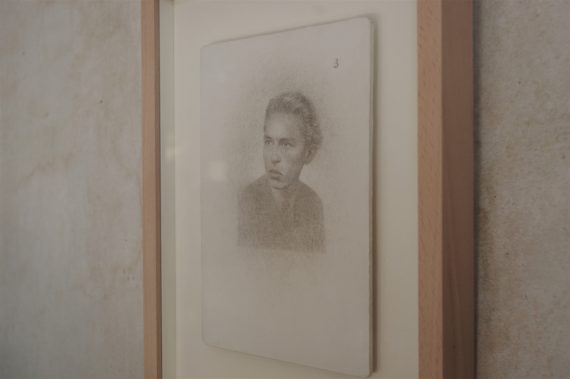This is blog number four of six:
The Beaney House of Knowledge and Art: The Front Room ‘Armchair Artist Residency’ blog.
Blog number four, December 2013:
I’ve installed an exhibition of my drawings and sketchbooks in The Drawing Room at The Beaney. I managed to squeeze everything that is in the exhibition into a couple of large shoulder bags and lug the whole lot over to Canterbury on the number 8 bus. The journey from Margate takes the best part of an hour and I’ve been doing this trip a lot since becoming the ‘Front Room Artist Armchair Resident’. This journey has become an important aspect of my ‘Residency’ at The Beaney. The bus takes me along a line in the landscape which has been there for centuries. Upstairs at the front of the bus is a good place to sit and notice things and to let my mind wander as the bus draws me across the East Kent landscape.
My exhibition consists of twenty sketchbooks and sixteen loose drawings (I’ve posted a video tour of it on my youtube channel to give you an idea of it). The loose drawings were done in The Beaney as part of the ‘Front Room Artist Armchair residency’ and the sketchbooks are all recent ones containing drawings of people. When I installed the work I made the decision to place drawings so that they might subtly relate to each other or direct the gaze in certain ways. There is no hidden message or overarching theme here. I simply thought that their placing might bring something extra into play in the mind of the viewer – it is whimsical. I offer my drawings as interesting things to look at and it’s up to the viewer to look at the drawings and notice things and let the mind wander.
None of these drawings were done for the purpose of being exhibited. They weren’t designed as ‘Works of Art’ or with an exhibition in mind. Each drawing was done separately and for its own sake. If they share a theme, it is that they are all drawings that pay attention to the physical presence of things. There are drawings of inanimate objects (made of marble, bronze and silver) that were made to look like people and there are drawings of real people being still. It’s a wonderful thing when someone is happy to be still and let you draw them. If I did nothing else with my life, drawing people would be a good use of a lifetime. I wish I could do it more often.
Across the room from my drawings is a small oblong-shaped piece of vellum covered in neat pen-and-ink hand-writing: The Godwine Charter. A thousand years ago it had a practical function as a legal document but now it has an afterlife as an object of contemplation in a museum. We can appreciate it as a kind of drawing. Hand-writing and the kind of lines you find in drawings are similar things. Both of them are products of human touch and of the time it took to draw them. That particular human presence and that particular moment of time are subtly replayed every time another person sees it. It is both trivial and wonderful. A similar effect can be felt in places too. My bus journey to Canterbury traces a line in the landscape which was already old when that scribe’s pen was forming those letters on that piece of vellum which sits across the room from my drawings.
We change our minds when we draw. ‘Objective Drawing’ is a process of continual revision (a good rule-of-thumb is that if your drawing isn’t going wrong then you’re just not trying hard enough!). Drawings are the trace-evidence of a mind making sense of things. They show us that someone was here and that they were interested in the presence of someone or of something outside of themselves.
You can watch a youtube video tour of the exhibition by clicking on this link:
https://www.youtube.com/watch?v=1PHLRDUvEB0






